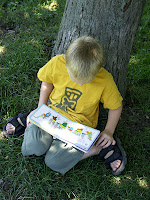It is the most frustrating stage children go through on the road to literacy! The stage I am referring to, is the one between word calling and comprehending. It's that fun stage where your child can sit down with a chapter book and 30minutes later come bouncing 'round the corner announcing "I'm Done!"....AHHHHHH!
Need I say more?! It is an endless battle not easily won unless you yourself have read the book and can quiz them on the spot. I realize that there are a few exceptional children out there, who may be natural speed readers. But in my experience, those individuals are few and far between. Most real reading is a process. Avid readers apply strategies naturally...asking questions and rereading when they do not fully understand. Beginning readers don't. They whiz on by words they don't know, understand, or completely ignore entire paragraphs that do not seem important to them. How do you fix this?! Well, a start is our beloved literature circles and guided reading. I have also found that partner reading helps. Students love to be the" know it all"! They absolutely love to point out when you have misread a word or just plain skipped it. Stopping to check for understanding is a bit trickier and takes many, many moons to achieve....but, this is definitely a start to slowing down and truly reading. My favorite "eaves dropping" experiences have been when the kiddos have finally begun to catch on to the importance of intonation, fluency and phrasing. They will stop their fellow readers and show them just how to say it. (**This is how you can pick your reader's theater stars! There are some kiddos out there who possess a natural knack for the dramatic flair!)
Responding to reading in both writing and oral discussion is a necessity in true comprehension and growth as a reader. I, like many others out there, have my students keep a reading response journal. This is not your standard reading response journal where students are filling out a basic story map. This is a series of letters between student and teacher about the books they are reading. I have used these at primary grades as well as upper elementary. They are definitely more in depth at 3rd, 4th and 5th grades than in 1st and 2nd, but none the less, very telling at all grades. Going over their letters with them is a great way to start off your individual reading conferences. Now be patient! These letters take some training and modeling, and modeling and training, and did I say modeling? You get the point! They take lots, and lots of guided practice to get them where they need to be. At first, students think that telling me the book was "good" and that they "liked it" should be sufficient. This is why throughout your modeling of a letter to the teacher after your read aloud, you take the time to point out various parts that you feel are important to you. My typical checklist is as follows:
Letter format: Straight forward letter format. Header, Greeting, Body, Closing, Signature. Every kiddo should know how to properly write a letter!
Handwriting/Conventions: these can be combined at the older grades, but in primary handwriting is still an important focus and I like to use this opportunity to practice application of good handwriting.
Evidence of strategies used: I want to hear about the connections they are making, the questions they are asking or wondering about, and the predictions they are making!
Answers questions from previous letters: This is unfortunately, the most forgotten but in my opinion, the most valuable! In my conferences, when a kiddo cannot answer my questions, I often ask what this tells them about their reading? How would a good reader address this issue? After much prompting and prodding, we get down to the golden answer....by REreading! Bingo! And the best part is, they said it, not me! After all, they know that they next time I talk with them, I will inevitable ask them the same question...AGAIN!!
I am attaching my rubric in the link below for your use. I am a numbers person, so I have assigned a numerical value for each assessed portion of the response. This could easily be adapted with simple changes, however I wanted to give you all a starting place. I use these to keep track of what I like to term, quality reading. It helps me gauge whether or not my reading workshop time is being utilized appropriately.
Reading Response Rubric
More to come on this subject! Thanks for reading!


No comments:
Post a Comment